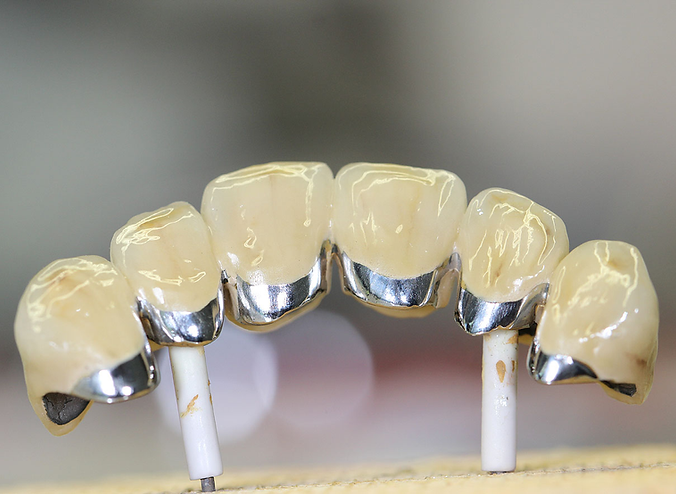
Metal-ceramic crowns
Metal-ceramic crowns are a type of dental restoration with a metal core covered by a ceramic material. These crowns are known for both their strength and aesthetic appearance. They are typically used on the posterior teeth, where chewing forces are greatest. While the metal base provides durability, in some cases it may cause a dark shadow or slight color difference near the gum line. Nevertheless, due to their relatively affordable price and long lifespan, metal-ceramic crowns are widely used.
What is a Metal-Ceramic Crown?
Metal-ceramic crowns, also known as porcelain-fused-to-metal (PFM) crowns, are a common type of dental crown used to restore and functionally reconstruct damaged or decayed teeth. These crowns are extremely popular among patients due to their strength, durability, and aesthetic appearance.

In what cases are metal-ceramic crowns used?
Metal-ceramic crowns are mainly used to protect and restore the function of teeth that are decayed, broken, weakened, or structurally compromised, or that cannot be restored with a large filling. These crowns allow the tooth to regain its shape, function, and appearance.
Metal-ceramic crowns are also considered an ideal choice for implant-supported dentures and abutment teeth for bridgework. These crowns, which have high strength due to their internal metal structure, are more advantageous in the back teeth - areas where chewing pressure is high.
With a slightly more advanced aesthetic planning, it can also be used on anterior teeth. In this case, the color selection and transparency properties of the ceramic coating are carefully adjusted so that the cap visually matches the natural tooth. Due to their affordable price, functional stability and longevity, metal-ceramic caps are one of the most common options in dental practice.

Advantages of metal-ceramic caps
Thanks to the internal metal structure, these caps are very resistant to chewing force and are suitable for long-term use on the back teeth.
Compared to zirconia and full ceramic crowns, metal-ceramic crowns are a more affordable budget option.
With proper care and regular dental maintenance, these caps can last for 10-15 years or more.
The outer ceramic layer can be matched to the natural tooth shape and color, especially when applied properly.
Disadvantages of Metal-Ceramic Crowns

-
Metal border may appear over time
As the gum recedes, the metal base of the cap becomes visible, which can ruin the aesthetic appearance – especially on the front teeth. -
Not as transparent as zirconia and all-ceramic
The ceramic layer appears less transparent because it does not transmit light as well as natural tooth. -
Risk of heavy metal allergy (although rare)
In some cases, allergic reactions to nickel-containing metals may occur. -
Aesthetically, limitations in front teeth
It provides less aesthetic results on front teeth compared to full ceramic and zirconia crowns.



Questions and answers about metal-ceramic crowns
3. Are metal-ceramic crowns suitable for front teeth? Although zirconia and all-ceramic crowns are generally preferred for front teeth due to better aesthetics, metal-ceramic crowns can also be used with proper shade selection to achieve a natural appearance.
1. How long can metal-ceramic crowns last? With proper care and regular dental check-ups, metal-ceramic crowns can last 10–15 years or even longer.
2. Can metal-ceramic crowns cause allergies? In rare cases, allergic reactions may occur to metals such as nickel found in the crown’s metal base. This risk should be considered by the dentist during material selection.
4. Can the metal part of a metal-ceramic crown become visible over time? Yes, as the gums recede, the metal base may become visible in some cases. This usually occurs when the gum level changes or if the crown is not placed properly.


